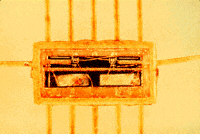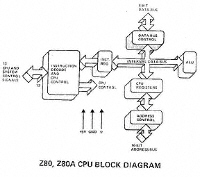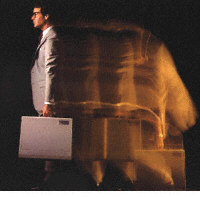 Williams tube
Williams tube
|
|
1947
The Williams tube won the race for a practical random-access memory. Sir
Frederick Williams of Manchester University modified a cathode-ray tube to
paint dots and dashes of phosphorescent electrical charge on the screen,
representing binary ones and zeros. Vacuum tube machines, such as the IBM
701, used the Williams tube as primary memory.

|
|
|
 Point-contact transistor
Point-contact transistor
|
|
1947
On December 23, William Shockley, Walter Brattain, and John Bardeen
successfully tested this point-contact transistor, setting off the
semiconductor revolution. Improved models of the transistor, developed at
AT&T Bell Laboratories, supplanted vacuum tubes used on computers at the
time.

|
|
|
 Core memory
Core memory
|
|
1953
At MIT, Jay Forrester installed magnetic core memory on the Whirlwind computer.
Core memory made computers more reliable, faster, and easier to make. Such
a system of storage remained popular until the development of semiconductors in
the 1970s.

|
|
|
 Regency radio
Regency radio
|
|
1954
A silicon-based junction transistor, perfected by Gordon Teal of Texas
Instruments Inc., brought the price of this component down to $2.50. A Texas
Instruments news release from May 10, 1954, read, "Electronic
"brains" approaching the human brain in scope and reliability came
much closer to reality today with the announcement by Texas Instruments
Incorporated of the first commercial production of silicon transistors
kernel-sized substitutes for vacuum tubes."
The company became a household name when the first transistor radio
incorporated Teal's invention. The radio, sold by Regency Electronics for $50,
launched the world into a global village of instant news and pop music.

|
|
|
 Felker and Harris program TRADIC
Felker and Harris program TRADIC
|
|
1955
AT&T Bell Laboratories announced the first fully transistorized computer,
TRADIC. It contained nearly 800 transistors instead of vacuum tubes.
Transistors -- completely cold, highly efficient amplifying devices invented at
Bell Labs -- enabled the machine to operate on fewer than 100 watts, or
one-twentieth the power required by comparable vacuum tube computers.
In this photograph, J. H. Felker (left) gives instructions to the TRADIC
computer by means of a plug-in unit while J. R. Harris places numbers into the
machine by flipping simple switches. The computer occupied only 3 cubic feet.

|
|
|
 IBM 305 RAMAC
IBM 305 RAMAC
|
|
1956
The era of magnetic disk storage dawned with IBM's shipment of a 305 RAMAC to
Zellerbach Paper in San Francisco. The IBM 350 disk file served as the
storage component for the Random Access Method of Accounting and Control.
It consisted of 50 magnetically coated metal platters with 5 million bytes of
data. The platters, stacked one on top of the other, rotated with a common
drive shaft.

|
|
|
 Kilby integrated circuit
Kilby integrated circuit
|
|
1958
Jack Kilby created the first integrated circuit at Texas Instruments to prove
that resistors and capacitors could exist on the same piece of semiconductor
material. His circuit consisted of a sliver of germanium with five components
linked by wires.

|
|
|
 Silicon integrated circuit
Silicon integrated circuit
|
|
1959
Robert Noyce's practical integrated circuit, invented at Fairchild Camera and
Instrument Corp., allowed printing of conducting channels directly on the
silicon surface.

|
|
|
 RTL integrated circuit
RTL integrated circuit
|
|
1961
Fairchild Camera and Instrument Corp. invented the resistor-transistor logic
(RTL) product, a set/reset flip-flop and the first integrated circuit available
as a monolithic chip.

|
|
|
|
|
1962
Virtual memory emerged from a team under the direction of Tom Kilburn at the
University of Manchester. Virtual memory permitted a computer to use its
storage capacity to run outside software and switch rapidly among multiple
programs.

|
|
|
 Fairchild NPN transistor
Fairchild NPN transistor
|
|
1962
Fairchild Camera and Instrument Corp. produced the first widely accepted
epitaxial gold-doped NPN transistor. The NPN transistor served as the industry
workhouse for discrete logic.

|
|
|
 MOS semiconductor
MOS semiconductor
|
|
1967
Fairchild Camera and Instrument Corp. built the first standard metal oxide
semiconductor product for data processing applications, an eight-bit arithmetic
unit and accumulator. In a MOS chip, engineers treat the semiconductor
material to produce either of two varieties of transistors, called n-type and
p-type.

|
|
|
|
|
1967
Using integrated circuits, Medtronics constructed the first internal pacemaker.

|
|
|
 Intel 4004
Intel 4004
|
|
1971
The first advertisement for a microprocessor, the Intel 4004, appeared in
Electronic News. Federico Faggin, Ted Hoff, and others at Intel designed the
4004 while building a custom chip for Busicom, a Japanese calculator maker.
The 4004 had 2,250 transistors, handling data in four-bit chunks, and could
perform 60,000 operations per second.

|
|
|
|
|
1971
An IBM team, originally led by Alan Shugart, invented the 8-inch floppy
diskette. It was initially designed for use in loading microcode into the
controller for the "Merlin" (IBM 3330) disk pack file. It quickly
won widespread acceptance as a program and data-storage medium. Unlike hard
drives, a user could easily transfer a floppy in its protective jacket from one
drive to another.

|
|
|
 Intel 8008
Intel 8008
|
|
1972
Intel's 8008 microprocessor made its debut. A vast improvement over its
predecessor, the 4004, its eight-bit word afforded 256 unique arrangements of
ones and zeros. For the first time, a microprocessor could handle both
uppercase and lowercase letters, all 10 numerals, punctuation marks, and a host
of other symbols.

|
|
|
 Zilog Z-80
Zilog Z-80
|
|
1974
Intel and Zilog introduced new microprocessors. Five times faster than its
predecessor, the 8008, the Intel 8080 could address four times as many bytes
for a total of 64 kilobytes. The Zilog Z-80 could run any program written for
the 8080 and included twice as many built-in machine instructions.

|
|
|
 5 1/4-inch floppy
5 1/4-inch floppy
|
|
1978
The 5 1/4" flexible disk drive and diskette were introduced by Shugart
Associates in 1976. This was the result of a request by Wang Laboratories to
produce a disk drive small enough to use with a desktop computer, since 8"
floppy drives were considered to be too large for that purpose. By 1978, more
than 10 manufacturers were producing 5 1/4" floppy drives.

|
|
|
 Motorola 68000
Motorola 68000
|
|
1979
The Motorola 68000 microprocessor exhibited a processing speed far greater than
its contemporaries. This high performance processor found its place in
powerful work stations intended for graphics-intensive programs common in
engineering.

|
|
|
 Introduction to VLSI Systems
Introduction to VLSI Systems
|
|
1979
California Institute of Technology professor Carver Mead and Xerox Corp.
computer scientist Lynn Conway wrote a manual of chip design,
"Introduction to VLSI Systems." Demystifying the planning of very
large scale integrated (VLSI) systems, the text expanded the ranks of engineers
capable of creating such chips. The authors had observed that computer
architects seldom participated in the specification of the standard integrated
circuits with which they worked. The authors intended "Introduction to
VLSI Systems" to fill a gap in the literature and introduce all electrical
engineering and computer science students to integrated system architecture.

|
|
|
|
|
1980
Seagate Technology created the first hard disk drive for microcomputers.
The disk held 5 megabytes of data, about fifty times as much as a standard
floppy disk, and fit in the space of a floppy disk drive. The hard disk
drive itself is a rigid metallic platter coated on both sides with a thin
layer of magnetic material that stores digital data. Along with the benefit
of increased storage, hard disks have one major drawback: Permanent installation
into the computer decreases their portability.
Seagate Technology grew out of a 1979 conversation between Alan Shugart and
Finis Conner, who had worked together at IBM. The two men decided to found the
company after developing the idea of scaling down a hard disk drive to the same
size as the then-standard 5 1/4-inch floppies. Upon releasing its first
product, Seagate quickly drew such big-name customers as Apple Computer and
IBM. Within a few years, it had sold 4 million units.

|
|
|
|
|
1980
The first optical data storage disk had 60 times the capacity of a 5 1/4-inch
floppy disk. Developed by Philips, the disk stored data as indelible marks
burned by a laser that could not be overwritten -- making it useful primarily
for storing large quantities of information that would never need revision.
Two years later, Philips created an erasable optical disk using special
material, a laser, and magnetism to combine the capacity of an optical disk
with the convenience of an option to erase and rewrite.
A laser beam recording a spiral of information on a photosensitive surface
produces an optical disk. Two layers of clear plastic protect the metal
surface on which the information is recorded. On erasable optical disks, also
called magneto-optic disks, the entire metal surface is magnetized in one
direction. Instead of recording information permanently by melting holes in
the metal, the laser heats a spot to just below its melting point so a magnet
can reverse the direction of the metal's magnetic flux. Reheating the disk to
restore its original orientation erases it.

|
|
|
|
|
1981
Sony introduced and shipped the first 3 1/2" floppy drives and diskettes
in 1981. The first signficant company to adopt the 3 1/2" floppy for
general use was Hewlett-Packard in 1982, an event which was critical in
establishing momentum for the 3 1/2" format and which helped it prevail
over the other contenders for the microfloppy standard, including 3 1/4",
3", and 3.9" formats.

|
|
|
|
|
1985
Able to hold 550 megabytes of prerecorded data, the new CD-ROMs grew out of
regular CDs on which music is recorded. Their capacity is great enough that
they rarely fill up, even with information that would take up thousands of
pages of paper.
The first general-interest CD-ROM product released after Philips and Sony
announced the CD-ROM in 1984 was "Grolier's Electronic Encyclopedia,"
which came out in 1985. The 9 million words in the encyclopedia only took up
12 percent of the available space. The same year, computer and electronics
companies worked together to set a standard for the disks so any computer would
be able to access the information.

|
|
|
|
|
1986
David Miller of AT&T Bell Labs patented the optical transistor, a component
central to digital optical computing. Called Self-ElectroOptic-Effect Device,
or SEED, the transistor involved a light-sensitive switch built with layers of
gallium arsenide and gallium aluminum arsenide. Beams of light triggered
electronic events that caused the light either to be transmitted or absorbed,
thus turning the switch on or off.
Within a decade, research on the optical transistor led to successful work on
the first all-optical processor and the first general-purpose all-optical
computer. Bell Labs researchers first demonstrated the processor there in
1990. A computer using the SEED also contained lasers, lenses, and fast light
switches, but it still required programming by a separate, non-optical
computer. In 1993, researchers at the University of Colorado unveiled the
first all-optical computer capable of being programmed and of manipulating
instructions internally.

|
|
|
 Compaq
Compaq
|
|
1986
Compaq beat IBM to the market when it announced the Deskpro 386, the first
computer on the market to use Intel's new 80386 chip, a 32-bit microprocessor
with 275,000 transistors on each chip. At 4 million operations per second and
4 kilobytes of memory, the 80386 gave PCs as much speed and power as older
mainframes and minicomputers.
The 386 chip brought with it the introduction of a 32-bit architecture, a
significant improvement over the 16-bit architecture of previous
microprocessors. It had two operating modes, one that mirrored the segmented
memory of older x86 chips, allowing full backward compatibility, and one that
took full advantage of its more advanced technology. The new chip made
graphical operating environments for IBM PC and PC-compatible computers
practical. The architecture that allowed Windows and IBM OS/2 has remained in
subsequent chips.

|
|
|
 Motorola 68030
Motorola 68030
|
|
1987
Motorola unveiled the 68030 microprocessor. A step up from the 68020, it built
on a 32-bit enhanced microprocessor with a central processing unit core, a data
cache, an instruction cache, an enhanced bus controller, and a memory
management unit in a single VLSI device -- all operating at speeds of at least
20 MHz.

|
|
|
|
|
1988
Compaq and other PC-clone makers developed enhanced industry standard
architecture -- better than microchannel and retained compatibility with
existing machines. EISA used a 32-bit bus, or a means by which two devices can
communicate. The advanced data-handling features of the EISA made it an
improvement over the 16-bit bus of industry standard architecture. IBM's
competitors developed the EISA as a way to avoid paying a fee to IBM for its
MCA bus.

|
|
|
 Intel 80486
Intel 80486
|
|
1989
Intel released the 80486 microprocessor and the i860 RISC/coprocessor chip,
each of which contained more than 1 million transistors. The RISC
microprocessor had a 32-bit integer arithmetic and logic unit (the part of the
CPU that performs operations such as addition and subtraction), a 64-bit
floating-point unit, and a clock rate of 33 MHz.
The 486 chips remained similar in structure to their predecessors, the 386
chips. What set the 486 apart was its optimized instruction set, with an
on-chip unified instruction and data cache and an optional on-chip
floating-point unit. Combined with an enhanced bus interface unit, the
microprocessor doubled the performance of the 386 without increasing the clock
rate.

|
|
|
 Motorola 68040
Motorola 68040
|
|
1989
Motorola announced the 68040 microprocessor, with about 1.2 million
transistors. Due to technical difficulties, it didn't ship until 1991,
although promised in January 1990. A 32-bit, 25-MHz microprocessor, the 68040
integrated a floating-point unit and included instruction and data caches.
Apple used the third generation of 68000 chips in Macintosh Quadra computers.

|





